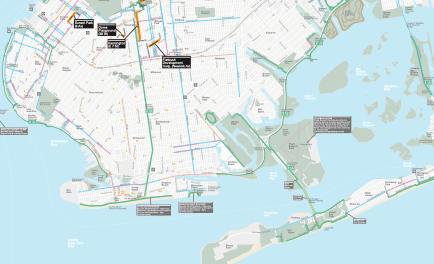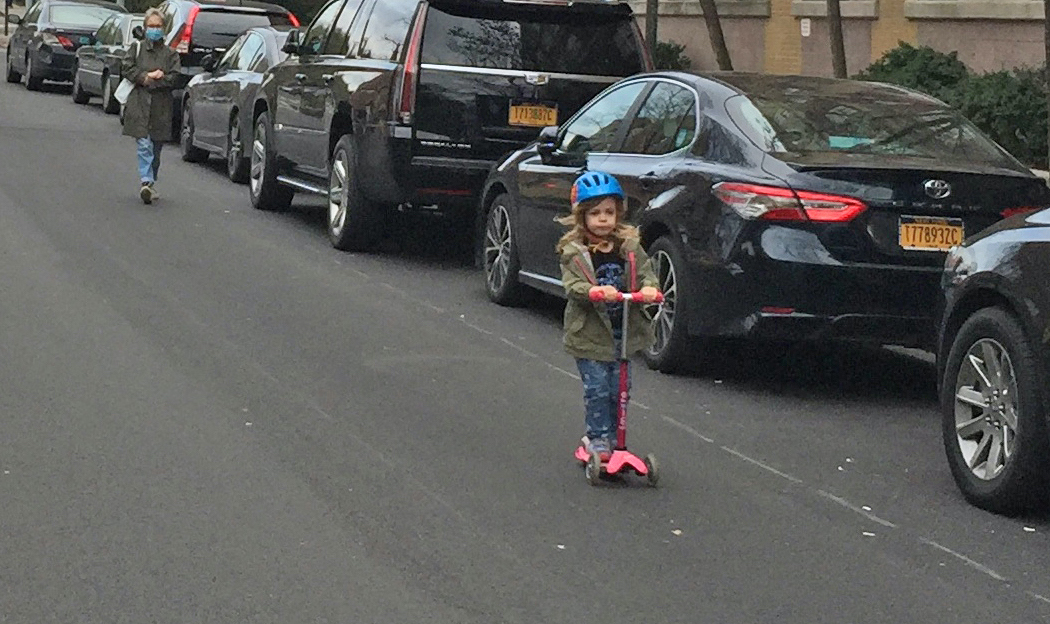One hundred miles just isn't enough!
Transportation Alternatives, plus a diverse collection of neighborhood groups, non-profits, business and civics, is calling on Mayor de Blasio to "expand the size and scope" of his open streets program, which is about one-third of the way towards its 100-mile goal. The groups called open streets "vital to New York City’s recovery" in an "open letter" to the mayor. (The full text is here.)
The letter from the six-dozen groups represents the latest call for the mayor to not only address the current COVID-19 crisis, but also get ahead of an expected influx of car commuters who are reluctant to take transit as the pandemic wanes. Earlier in the month, restaurant industry leaders called for the mayor to set aside open space so eateries could reopen to serve — and employ — New Yorkers.
"Car-filled streets, crowded sidewalks, and packed subway cars pose a public health risk and impede our city’s recovery," said the Transportation Alternatives letter, which also supported the restaurant industry effort. "The Open Streets plan you initiated is commendable. We urge you to think bigger."
Primarily, the mayor has conceived of his open streets program as a temporary effort to give residents more space for socially responsible recreation and exercise. He has also started rolling out nine miles of temporary bike lanes on top of two earlier stretches in Brooklyn and Manhattan.
But TA and its fellow organizations say the open streets plan is not doing enough for safe movement.
"Open streets must also be networks for alternative transportation — allowing New Yorkers to safely reach essential destinations ... and introduce cleaner air in neighborhoods plagued by pollution and disproportionately affected by COVID-19," the letter says.
The groups also vaguely refer to the current effort as failing many neighborhoods. In its initial phase, most of the open streets have been in existing parks or in well-to-do areas. (See the city's own map here.)
"Open Streets should also be an equity tool where health outcomes are most disparate and public space needs are most apparent," the groups said. "New York City’s economic recovery can not be achieved without open streets. ... We call on you to think big and take necessary action on this transformative idea now."
TransAlt cited data to back up its contention that open streets are essential to the city's economic and health revival.
"The city's own data show that bike lanes and pedestrian plazas increase business activity, and DOTs own data show that fewer cars make roadways safer and that areas get healthier with more pedestrianization," said Marco Conner DiAquoi, the group's deputy director. "There's an overwhelming body of data."

City Hall found the letter a bit odd, given that the open streets program is still ramping up to its full 100 miles, and that the mayor and Department of Transportation Commissioner Polly Trottenberg have publicly committed to ensuring the program reaches the neighborhoods that need it most.
"As summer approaches, the mayor has left no doubt: everyone deserves a chance to enjoy the outdoors and safely get a breath of fresh air," said City Hall spokesman Mitch Schwartz. "We're excited to see New Yorkers of every background embrace this program, and we look forward to working with the City Council to add more streets in the weeks and months ahead."
Conner DiAquoi was not satisfied.
"If you look at the census tracts and where open streets have been implemented already, those streets are significantly above the city average when it comes to household income, and they are heavily white," he said. "So thus far they have not been equitably implemented."
Perhaps the most impressive thing about the TransAlt open letter was the huge and diverse list of signatories:
- 510 W. 134 Tenant Association
- Sixth Street Community Coalition
- 89th Street Tenants Unidos Association
- Acupuncture Mobile Services
- Art of Cycling
- Bedford-Stuyvesant Restoration Corporation
- Bike New York
- BRAKES
- Brompton Bicycle
- Brompton Junction NYC
- Bronx Health REACH
- Brooklyn Crepe
- Brooklyn Greenway Initiative
- Ciclistas Latinoamericanos de Nueva York
- Court Square Civic
- COVID Care Neighbor Network
- Community Relief & Rebuilding through Education & Wellness (CREWW)
- Downtown Brooklyn Partnership
- DUMBO Improvement District
- East Village Vintage Collective
- East Village Wellness Circle
- Families for Safe Streets
- Financial District Neighborhood Association
- Five Boro Pizza Challenge
- Flatbush Development Corporation
- Flower Power
- Greater Flushing Chamber of Commerce
- Green Map System
- Hell's Kitchen Neighborhood Association
- Historic Tappen Park Community Partnership
- Hollaback!
- How To Be Broke in New York
- Hudson Clearwater
- Jackson Heights Beautification Group
- La Colmena
- League of American Bicyclists
- Make Brooklyn Safer
- Make Queens Safer
- Millennium Development
- Mos Collective
- New York League of Conservation Voters
- New Yorkers for Parks
- Newtown Creek Alliance
- North Brooklyn Neighbors
- North Brooklyn Parks Alliance
- NY Cycle Club
- Oonee Pod
- Open Plans (full disclosure: that is the parent company of Streetsblog)
- Out Cycling Inc.
- OUT Rockaway
- Ovenly
- Pakistani American Youth Society
- Park Slope Neighbors
- Pride Center of Staten Island
- Queens Bike Initiative
- Rachel Kaplan Acupuncture
- Regional Plan Association
- Riders Alliance
- Rocking the Boat
- Seemore Meats & Veggies
- Staten Island Partnership for Community Wellness
- Staten Island Therapeutic Gardens
- Straphangers Campaign
- Street Plans
- Street Vendor Project (Urban Justice Center)
- StreetsPAC
- The Trust for Public Land
- Together We Can
- Tri-State Transportation Campaign
- UP-STAND Movement
- West 134th St Block Association
- Workers Justice Project
- Youth BUILD






